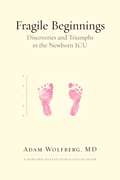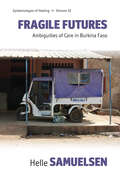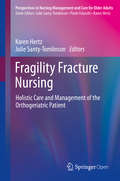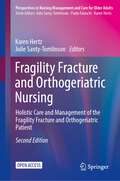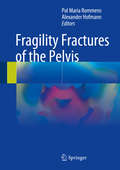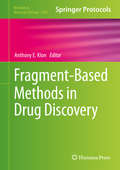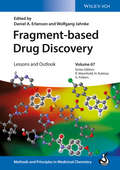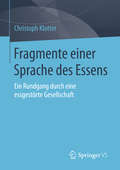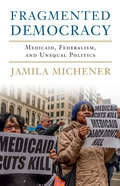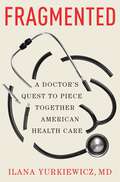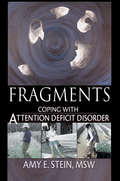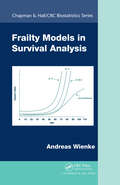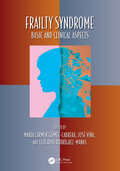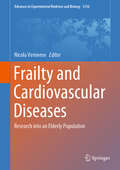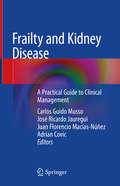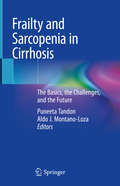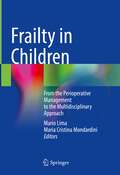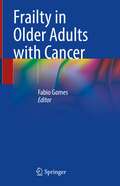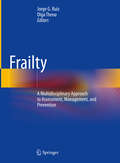- Table View
- List View
Fractures of the Wrist: A Clinical Casebook
by Nirmal C. TejwaniComprised exclusively of more than two dozen clinical cases covering common injuries of and around the wrist, this concise, practical casebook will provide clinicians with the best real-world strategies to properly manage open and closed fractures, dislocations and nonunions of the distal radius, scaphoid and perilunate. Each chapter is a case that opens with a unique clinical presentation with associated radiology, followed by a description of the diagnosis, assessment and management techniques used to treat it, as well as the case outcome and clinical pearls. Cases included illustrate the surgical management of intra- and extra-articular fractures and malunions of the distal radius - volar plating, k-wires and fracture-specific fixation - Galeazzi fractures, DRUJ fixation, scaphoid-scapholunate-perilunate dislocation and more, including pediatric cases.Pragmatic and reader-friendly, Fractures of the Wrist: A Clinical Casebook will be an excellent resource for orthopedic surgeons and sports medicine specialists confronted with these common injuries of the Wrist.
Fragile Beginnings
by Adam WolfbergThis is a gripping medical narrative that brings readers into the complex world of newborn intensive care, where brilliant but imperfect doctors do all they can to coax life into their tiny, injured patients. Dr. Adam Wolfberg--journalist, physician specializing in high-risk pregnancies, and father to a child born weighing under two pounds--describes his daughter Larissa's precipitous birth at six months, which left her tenuously hanging on to life in an incubator. Ultrasound had diagnosed a devastating hemorrhage in her brain that doctors reasoned would give her only a 50 percent chance of having a normal IQ. As they make decisions about live-saving care in the first hours of a premature infant's life, doctors and parents must grapple with profound ethical and scientific questions: Who should be saved? How aggressively should doctors try to salvage the life of a premature baby, who may be severely neurologically and physically impaired? What will that child's quality of life be like after millions of dollars are spent saving him or her? Wolfberg explores the fits and starts of physicians, government policy makers, and lawyers who have struggled over the years to figure out the best way to make these wrenching decisions. Through Larissa's early hospital course and the struggle to decide what is best for her, Wolfberg examines the limitations of newborn intensive-care medicine, neuroplasticity, and decision making at the beginning of life. Featuring high-profile scientific topics and explanatory medical reporting, this is the first book to explore the profound emotional and ethical issues raised by advancing technology that allows us to save the lives of increasingly undeveloped preemies.
Fragile Futures: Ambiguities of Care in Burkina Faso (Epistemologies of Healing #22)
by Helle SamuelsenCaring for small children and the family in Burkina Faso is hard work. Although the health infrastructure in Burkina Faso is weak and many citizens feel neglected by the state, Fragile Futures shows that the state continues to play an important role in people’s engagements and hopes for a better future. Based on more than twenty years of research engagement with Burkina Faso, it is an ethnography of how rural citizens address ambiguities of sickness and care and try to secure a decent future for themselves and their families.
Fragility Fracture Nursing: Holistic Care and Management of the Orthogeriatric Patient (Perspectives in Nursing Management and Care for Older Adults)
by Julie Santy-Tomlinson Karen HertzThis open access book aims to provide a comprehensive but practical overview of the knowledge required for the assessment and management of the older adult with or at risk of fragility fracture. It considers this from the perspectives of all of the settings in which this group of patients receive nursing care. Globally, a fragility fracture is estimated to occur every 3 seconds. This amounts to 25 000 fractures per day or 9 million per year. The financial costs are reported to be: 32 billion EUR per year in Europe and 20 billon USD in the United States. As the population of China ages, the cost of hip fracture care there is likely to reach 1.25 billion USD by 2020 and 265 billion by 2050 (International Osteoporosis Foundation 2016). Consequently, the need for nursing for patients with fragility fracture across the world is immense. Fragility fracture is one of the foremost challenges for health care providers, and the impact of each one of those expected 9 million hip fractures is significant pain, disability, reduced quality of life, loss of independence and decreased life expectancy. There is a need for coordinated, multi-disciplinary models of care for secondary fracture prevention based on the increasing evidence that such models make a difference. There is also a need to promote and facilitate high quality, evidence-based effective care to those who suffer a fragility fracture with a focus on the best outcomes for recovery, rehabilitation and secondary prevention of further fracture. The care community has to understand better the experience of fragility fracture from the perspective of the patient so that direct improvements in care can be based on the perspectives of the users.This book supports these needs by providing a comprehensive approach to nursing practice in fragility fracture care.
Fragility Fracture and Orthogeriatric Nursing: Holistic Care and Management of the Fragility Fracture and Orthogeriatric Patient (Perspectives in Nursing Management and Care for Older Adults)
by Julie Santy-Tomlinson Karen HertzThis second edition, in Open Access, aims to provide a comprehensive and practical overview of the knowledge required for the assessment and management of the older adult with or at risk of fragility fracture, with additional focus on those who are frail. It considers this from the perspectives of all the clinical and home care settings in which this group of patients receive care and is relevant to all global locations. The concept of orthogeriatric care is explored in detail. Global estimates suggest that there were 21 million men and 137 million women aged 50 years or more at high fracture risk in 2010. This incidence is expected to double by 2040, with the most significant increase in Asia. Fragility fracture is one of the foremost challenges for health care providers and thehe global demand for nursing care for patients with fragility fractures across the world is immense. Hip fracture is particularly challenging as these significant injuries often occur in frail older people requiring hospitalisation and orthopaedic surgery. Such injuries and associated surgery result in increased frailty, worsening health and wellbeing, pain, disability, reduced quality of life, loss of independence, and decreased life expectancy. Care providers need to understand the experience of fragility fracture from the perspective of patients and families so that direct improvements in care can be based on the perspectives of the users. Expert care of patients following fractures that require hospitalisation and orthopaedic surgery involves skill in the care and treatment of frail older people as we as individuals with an injury and undergoing surgery. Nurses have a significant role in interdisciplinary collaborative care provided through orthogeriatric models of care. There is increasing evidence that such models significantly improve patient outcomes. High quality, evidence-based orthogeriatric care is increasingly shown to have positive impact on outcomes for recovery, rehabilitation, and secondary prevention of further fracture. This book significantly supports the aims and values of the Fragility Fracture Network and, as such, supports the learning needs of nurses and other allied health professionals which will enable a comprehensive approach to nursing practice in orthogeriatric and fragility fracture care.
Fragility Fractures of the Pelvis
by Pol Maria Rommens Alexander HofmannThanks to an increasing life expectancy of our populations the number of elderly persons is steadily growing and will continue to do so. Among these, the rate of persons with illnesses and degenerative diseases is significant. The prevalence of osteoporosis is especially high in elderly women and leads to typical fracture patterns. Hip fractures, proximal humerus fractures, distal radius fractures and fractures of the vertebral column are the most common. In the last decade, we are confronted with a sharp increase of fragility fractures of the pelvis. Until now, there is no consensus on how to identify and classify these lesions and there are no guidelines for treatment and after treatment. In particular, there is no common view on which patients need an operative treatment and which technique of osteosynthesis should be used. This book fills the gap in available literature and gives a state of the art guide to the treatment of fragility fractures of the pelvis. With the sharp increase of these fractures and the lacking consensus, Fragility Fractures of the Pelvis will become indispensable for the physicians who take care of elderly patients with this pathology. Written by a team of expert opinion leaders, the aim of this book is to contribute to the scientific discussion in this area and to help provide the optimal care for these patients.
Fragilitätsfrakturen des Beckenrings (essentials)
by Reiner Bartl Axel Gänsslen Thomas Mendel Philipp KobbeThema dieses Buches sind die Fragilitätsfrakturen des Beckens aus interdisziplinärer Sicht. Als ein Indikationsfaktor für Osteoporose zeigen Fragilitätsfrakturen des Beckens regelhaft ein typisches Frakturmuster mit der Gefahr einer Frakturprogression und einer konsekutiven Instabilitätszunahme. In der Diagnostik fokussiert die erweiterte Bildgebung (CT und/oder MRT) den hinteren Beckenring. Therapeutisch ist das primäre Behandlungsmanagement eine zweiwöchige konservative Therapie, wohingegen höhergradige Instabilitäten v.a. des hinteren Beckenrings eine operative Therapie erfordern. Eine therapiebegleitende Osteoporosebehandlung ist zwingend erforderlich.
Fragment-Based Drug Discovery and X-Ray Crystallography
by Thomas G. Davies Marko HyvönenIntroduction to Fragment-Based Drug Discovery, by Daniel A. Erlanson Fragment Screening Using X-Ray Crystallography, by Thomas G. Davies and Ian J. Tickle Hsp90 Inhibitors and Drugs from Fragment and Virtual Screening, by Stephen Roughley, Lisa Wright, Paul Brough, Andrew Massey and Roderick E. Hubbard Combining NMR and X-ray Crystallography in Fragment-Based Drug Discovery: Discovery of Highly Potent and Selective BACE-1 Inhibitors, by Daniel F. Wyss, Yu-Sen Wang, Hugh L. Eaton, Corey Strickland, Johannes H. Voigt, Zhaoning Zhu and Andrew W. Stamford Combining Biophysical Screening and X-Ray Crystallography for Fragment-Based Drug Discovery, by Michael Hennig, Armin Ruf and Walter Huber Targeting Protein-Protein Interactions and Fragment-Based Drug Discovery, by Eugene Valkov, Tim Sharpe, May Marsh, Sandra Greive and Marko Hyvönen Fragment Screening and HIV Therapeutics, by Joseph D. Bauman, Disha Patel and Eddy Arnold Fragment-Based Approaches and Computer-Aided Drug Discovery, by Didier Rognan
Fragment-Based Methods in Drug Discovery
by Anthony E. KlonThis volume covers the techniques necessary for a successful fragment-based drug design project, beginning from defining the problem in terms of preparing the protein model, identifying potential binding sites, and the consideration of various candidate fragments for simulation. The second part discusses the technical aspects that various methods have used to simulate fragment binding to a target protein by using Monte Carlo, molecular dynamics, and docking algorithms. After simulations, fragments are assembled into molecules using a variety of approaches, which are explored next. A discussion of design strategies and consideration of drug-like properties is included as part of the design process at this stage. Finally, several examples of successful fragment-based drug design projects are presented. Written for the Methods in Molecular Biology series, this work contains the kind of detailed description and implementation advice to encourage success in the lab. Practical and cutting-edge, Fragment-Based Methods in Drug Discovery takes into account the great accomplishments in the field to provide an ideal guide for researchers continuing to investigate this exciting area of pharmacological study.
Fragment-based Drug Discovery
by Raimund Mannhold Gerd Folkers Hugo Kubinyi Wolfgang Jahnke Daniel A. ErlansonFrom its origins as a niche technique more than 15 years ago, fragment-based approaches have become a major tool for drug and ligand discovery, often yielding results where other methods have failed. Written by the pioneers in the field, this book provides a comprehensive overview of current methods and applications of fragment-based discovery, as well as an outlook on where the field is headed. The first part discusses basic considerations of when to use fragment-based methods, how to select targets, and how to build libraries in the chemical fragment space. The second part describes established, novel and emerging methods for fragment screening, including empirical as well as computational approaches. Special cases of fragment-based screening, e. g. for complex target systems and for covalent inhibitors are also discussed. The third part presents several case studies from recent and on-going drug discovery projects for a variety of target classes, from kinases and phosphatases to targeting protein-protein interaction and epigenetic targets.
Fragmente einer Sprache des Essens
by Christoph KlotterDer vorliegende Band beschäftigt sich zum einen mit der Reduktion des Essens auf eine naturwissenschaftliche Perspektive und moralisches Gebot und hebt zum anderen die kulturelle und soziale Bedeutung hervor. Seit der Entstehung der Ernährungswissenschaft Mitte des 19. Jahrhunderts haben wir uns daran gewöhnt, von Vitaminen, Proteinen und Kohlehydraten zu sprechen. Wir betrachten Lebensmittel aus naturwissenschaftlicher Sicht, lösen sie in einzelne Bestandteile auf und quantifizieren diese, um festzustellen, wie viel wir von welchem Inhaltsstoff zu uns nehmen müssen, um uns gesund zu ernähren. Die Ernährung hat dann die primäre Aufgabe, die Gesundheit zu erhalten und das Leben zu verlängern. Wer sich dieser Aufgabe verweigert, wie vermeintlich die Adipösen, darf moralisch verurteilt werden. Ernährung und Gesundheit haben sich so moralisiert. Somit wird mittels der empfohlenen Ernährung ein zentraler abendländischer Wert vermittelt, der der Mäßigung. Von Platon bis zur protestantischen Ethik, die unser Leben heute bestimmt, wird Mäßigung eingefordert, heute über das rigide Schlankheitsideal.
Fragmented Democracy: Medicaid, Federalism, and Unequal Politics
by Jamila MichenerMedicaid is the single largest public health insurer in the United States, covering upward of 70 million Americans. Crucially, Medicaid is also an intergovernmental program that yokes poverty to federalism: the federal government determines its broad contours, while states have tremendous discretion over how it is designed and implemented. Where some locales are generous and openhanded, others are tightfisted and punitive. In Fragmented Democracy, Jamila Michener demonstrates the consequences of such disparities for democratic citizenship. Unpacking how federalism transforms Medicaid beneficiaries’ interpretations of government and structures their participation in politics, this book examines American democracy from the vantage point(s) of those who are living in or near poverty, (disproportionately) black or Latino, and reliant on a federated government for vital resources.
Fragmented: A Doctor's Quest to Piece Together American Health Care
by Ilana Yurkiewicz MDAn award-winning physician-writer exposes how pervasive cracks in the health care system cost us time, energy, and lives—and how we can fix them. There’s an unspoken assumption when we go to see a doctor: the doctor knows our medical story and is making decisions based on that story. But reality frequently falls short. Medical records vanish when we switch doctors. Critical details of life-saving treatment plans get lost in muddled electronic charts. The doctors we see change according to specialty, hospital shifts, or an insurer’s whims. Physician Ilana Yurkiewicz calls this phenomenon fragmentation, and, she argues, it’s the central failure of health care today. In this gripping narrative from medicine’s front lines, Yurkiewicz reveals how a system that doesn’t talk to itself puts insupportable burdens on physicians, patients, and caregivers, forcing them to heroic lengths to hold the pieces together—barely. The stories she tells are at once harrowing and commonplace. A patient narrowly averts an unnecessary, invasive heart procedure by producing a worn rhythm strip he has carried in his pocket for a decade. A man diagnosed with leukemia while visiting from abroad has thirty-one physicians, but no one he can call “his” doctor, with tragic consequences. When Yurkiewicz’s own father falls ill, a culture that incentivizes health care providers to react with quick fixes to the problems immediately before them—often to the neglect of a patient’s overall narrative—leads to weeks of additional suffering and a risky hospital transfer. The system is hanging by a thread, and we need better solutions. Yurkiewicz issues a clear-eyed call for change, naming concrete reforms doctors and policymakers can make, and empowering patients and their loved ones to advocate for themselves in the meantime. Urgent, radiantly humane, and ultimately hopeful, Fragmented a prescription for what really needs fixing in modern medicine.
Fragments
by James N. DavidsonBrilliant psychologists have assembled in a small college town to conduct a revolutionary experiment that challenges the very nature of identity and individuality. Their subjects are savants, mentally and emotionally challenged individuals, each of whom possesses an amazing gift. One person can calculate calendar dates backward and forward, while another can memorize an entire library or assemble jigsaw puzzles at the speed of lightning. . Each of these very special people is flawed and psychologically handicapped, but what if five such savants are cybernetically linked together to create a sixth composite personality? Can this newly created entity be more than the sum of its parts? At first the experiment yields promising results, but a terrifying secret in the past will transform the project in ways the researchers never anticipated-and infect the newborn intelligence with a catastrophic thirst for vengeance. Soon all of them are at risk to become killers or to be killed. Good intentions and care for safety are overwhelmed by escalating powers, and the struggle to contain those lethal powers and to survive. Tension begins early in the book as a man with the secret power to control others insinuates himself in to the experiment. The suspense mounts rapidly to breathtaking levels. Scientific and emotional thinkers combine efforts to stop the destructive rampage they started. The subjects of the experiments, all with one special gift superimposed on limited intellects, are sympathetically and fascinatingly examined. Each has a part to play in this gripping novel about human and superhuman nature.
Fragments: Coping with Attention Deficit Disorder
by Amy E SteinExplore effective alternative approaches to improving the lives of those diagnosed with attention deficit disorder!This remarkable new book offers fresh perspectives on ADD/ADHD. Even more important, it provides new direction for sufferers, introducing an ecologically based lifestyle that focuses on hands-on interactive learning. Fragments: Coping with Attention Deficit Disorder shows how to use environmental education and activities such as organic farming, community service, mission work, art, yoga, meditation, and spirituality to bring about positive change in people diagnosed with ADD or ADHD.From author Amy E. Stein: “This book is about life. It is written for those who think they have no hope, who struggle with life, with decisions, with addiction, and in search of themselves. I do not believe traditional psychotherapy or medication are solutions for those of us who fall under the label of ADD or ADHD.”Candidly written by a woman who, at age 25, was diagnosed as “a textbook case for attention deficit hyperactivity disorder,” this insightful book examines: the pitfalls of traditional psychotherapy and medication for those diagnosed with ADD/ADHD how an interactive hands-on learning environment can markedly improve the educational experience of ADD/ADHD kids how an organic, holistic approach can benefit those diagnosed with ADD/ADHD the correlation between agriculture and ADD/ADHD and the impact of eliminating pesticides and increasing fatty acid intake in the diets of sufferers how incorporating spirituality and faith into ADD/ADHD sufferers&’ lives can help to add discipline and bring greater satisfaction and much more!Five helpful appendices give you easy access to environmental education resources, agricultural resources, a sample agricultural curriculum, a sample ecology curriculum, and an environmental art curriculum.
Fragrance and Wellbeing: Plant Aromatics and Their Influence on the Psyche
by Jennifer Peace RhindFor thousands of years fragrance has been used, across many varied cultures, for altering mental and emotional states, and as part of spiritual practice. This book explores the impact of fragrance on the psyche from biological, anthropological, perfumery and aromatherapy viewpoints. Beginning with an exploration of our olfactory system and a discussion of the language of odour, the book examines the ways in which fragrance can influence our perceptions and experiences. It introduces us to a broad range of fragrance types - woody, resinous, spicy, herbaceous, agrestic, floral and citrus, as well as the attars that form part of Unani Tibb medicine. Traditional and contemporary uses and the mood-enhancing properties of fragrance types are presented. The book then provides an overview of the theoretical and philosophical frameworks that have been used to analyse how and why we choose fragrance. Finally readers are given guidance on how to cultivate their olfactory palate, which reveals a new dimension in the use of fragrance to enhance wellbeing. This book offers a wealth of knowledge on plant aromatics and the powerful influence of fragrance on wellbeing. It will be of particular interest to aromatherapists, perfumers, psychotherapists, ethnobotanists and anthropologists.
Frailty Models in Survival Analysis (Chapman & Hall/CRC Biostatistics Series)
by Andreas WienkeThe concept of frailty offers a convenient way to introduce unobserved heterogeneity and associations into models for survival data. In its simplest form, frailty is an unobserved random proportionality factor that modifies the hazard function of an individual or a group of related individuals. Frailty Models in Survival Analysis presents a compreh
Frailty Syndrome: Basic and Clinical Aspects (Oxidative Stress and Disease)
by José Viña Leocadio Rodríguez-MañasFrailty, a geriatric syndrome with a defined phenotype, was introduced by Linda Fried and Jeremy Walston; it is widely cited. The importance of this syndrome cannot be overstated: Frailty has an enormous relevance in clinical settings, and there are clear biological bases behind its phenotype. This book covers both biological and clinical aspects, including interactions with diseases like diabetes.Key Features: Summarizes the history and recognition of the Frailty Syndrome Provides an update and summary of a fast-growing field Describes how free radical and oxidative stress contributed to current theories Documents the impact that nutrition and physical activity play in the emergence of frailty
Frailty and Cardiovascular Diseases: Research into an Elderly Population (Advances in Experimental Medicine and Biology #1216)
by Nicola VeroneseThis book aims to clarify the potential association between frailty and cardiovascular disease in older people. Covering the biological as well as the clinical point of view, it allows researchers and clinicians to discover the significance of this topic. The contributions cover the most important aspects in the potential relationship between frailty and cardiovascular disease. In particular, authoritative authors in this field have clarified the definition and the epidemiology of frailty and cardiovascular disease in older people. A large part of the volume is dedicated to the biological mechanisms of frailty and cardiovascular disease, trying to find those in common between these two conditions. Since this book is dedicated to both researchers and clinicians, we have proposed some chapters to the importance of comprehensive geriatric assessment in the evaluation and treatment of cardiovascular diseases and frailty. In this regard, the importance of geriatric evaluation in cardiac surgery for older people is well covered. Finally, the importance of cardiac rehabilitation and physical exercise is summarized, being, actually, the most important treatments for both frailty and cardiovascular disease. Written by many well-known and widely published experts in their respective fields, this book will appeal to a wide readership such as researchers in the field and clinicians, especially suited in geriatric medicine and cardiology who, every day, face frail older patients.
Frailty and Kidney Disease: A Practical Guide to Clinical Management
by Adrian Covic Carlos Guido Musso José Ricardo Jauregui Juan Florencio Macías-NúñezThis unique book reviews the information available in the literature regarding the new syndrome, frailty, in patients with various renal conditions, such as acute kidney injury, chronic kidney disease, as well as dialysis and transplant patients. The topic is of importance in nephrology, specifically nephrogeriatrics, since frailty is a condition affecting many elderly patients and which is becoming increasingly common in medical practice. As such, there is a considerable need for information to assist professionals treating these patients. The book includes chapters on the frailty syndrome (definition, evaluation and treatment), the main geriatric syndromes (gait disorder, falls, incontinence, and delirium), the main renal syndromes (acute renal injury, chronic kidney disease) as well as dialysis and kidney transplant, and the relationship between geriatrics and renal syndromes. Frailty and Kidney Disease: A Practical Guide to Clinical Management is an essential resource for general practitioners, researchers, internal medicine physicians, geriatricians, and nephrologists.
Frailty and Sarcopenia in Cirrhosis: The Basics, the Challenges, and the Future
by Puneeta Tandon Aldo J. Montano-LozaThis book provides a concise yet comprehensive overview of frailty and sarcopenia in the cirrhotic patient. The text presents a personalized approach to identifying cirrhotic patients at risk of higher morbidity and mortality due to frailty and sarcopenia. It reviews current and novel diagnostic methods, while spotlighting treatment and management strategies for frailty and sarcopenia. The book also focuses on special issues associated with these syndromes, such as the effect of gender, age, and ethnicity on frailty and sarcopenia, sarcopenic obesity, and frailty and sarcopenia after liver transplantation. Future considerations are outlined in the closing chapters, including emerging pharmacological and interventional therapies for these syndromes.Written by experts in the field, Frailty and Sarcopenia in Cirrhosis: The Basics, the Challenges, and the Future is a valuable resource for clinicians and practitioners who treat patients with cirrhosis.
Frailty in Children: From the Perioperative Management to the Multidisciplinary Approach
by Mario Lima Maria Cristina MondardiniThis book focuses on the management strategies of complex conditions of frail pediatric patients. The clinical condition of frailty is usually seen as the physiological and multidimensional decline of organ systems related to age: paradoxically, a frailty condition can also occur in children as a disability resulting from various congenital or acquired diseases. The fragile patients are more vulnerable to developing severe clinical events and often need surgical interventions. Moreover, those patients have significant morbidity and lower quality of life. The improvement in managing fragile patients has improved their life expectancy, but in most health care systems, the passage from childhood to adulthood is a critical point for the lack of medical figures able to provide the continuity of care. The book aims to provide guidance for dealing with medical and surgical emergencies and to develop short and long-term treatment strategies, and will provide an analysis of the different and the most innovative techniques. This book will be an unvaluable tool for Pediatric surgeons, Anesthesiologists, Critical Care Physicians, Hospital and family Pediatricians, nurses, Physiotherapists and Psychologists.
Frailty in Older Adults with Cancer
by Fabio GomesThis book summarizes evidence on frailty and ageing, how this may impact patient outcomes and how frailty can be assessed, managed and incorporated in the decision-making process for older patients with cancer. The book aims to: empower clinical teams to assess and support older cancer patients with frailty, ideally within a multidisciplinary setting; and to improve the selection of older cancer patients to the most appropriate management/treatment strategies in order to improve the outcomes of this group of patients often underrepresented in research. The reader will learn the methods available for assessing frailty, such as screening tools, but also how to perform different geriatric assessments covering the different key components (physical, nutritional, social, psychological, etc.). The book also provides information on how to manage and intervene on frailty with the role of pre-habilitation and re-habilitation, how to set-up specialised teams and pathways within one’s hospital and community for these older cancer patients with frailty. Finally, the management of this challenging group of patients according to the cancer type is discussed in detail, alongside with mapping the unmet research needs and future directions in this field.
Frailty: A Multidisciplinary Approach to Assessment, Management, and Prevention
by Jorge G. Ruiz Olga TheouThis book offers a thorough examination of frailty, covering its complexity through sections on foundational concepts, pathogenesis research, assessment methods, management strategies, care settings, its relation to other chronic conditions, and societal implications. It provides a deep understanding of frailty's scientific basis, advanced assessment tools, innovative management, and prevention approaches, and examines frailty within diverse care settings and in relation to other health conditions. By integrating multidisciplinary insights, it presents a holistic view of frailty, addressing its clinical, societal, and policy-related aspects, aiming to enhance well-being and inform clinical practitioners, educators, and policymakers.This book can serve as a reference guide with up-to-date information on frailty in older adults for geriatric medicine physicians, primary care clinicians, geroscience researchers, nurses, therapists (OT, PT, ST), and social workers.
Frakturen der Mittelhand und Finger: Eine Übersicht für Ärzte aller Fachgebiete (essentials)
by Frank Unglaub Adrian Cavalcanti KußmaulFrakturen von Fingern und Mittelhand stellen gemeinsam die häufigsten Frakturen dar. Klinisch kann es neben Schwellungen, Hämatomen und Schmerzen auch zu Funktionseinschränkungen kommen. Die Diagnostik umfasst neben klinischer Untersuchung auch bildgebende Verfahren, insbesondere röntgenologische Untersuchungen. Therapeutisch sollte neben dem Funktionserhalt insbesondere der individuelle Anspruch im Vordergrund stehen.

